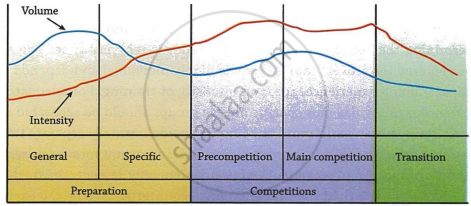Advertisements
Advertisements
Question
Diagrammatically represent the periodisation cycle Hierarchy and explain the same.
Solution

Periodisation cycle
| Periodisation Cycle Hierarchy | |
| Periodisation Cycle | Description |
| Quadrennial cycle | Multi-year plan: 4 years |
| Macro cycle | Describes the complete training Period: 1 year |
| Meso cycle (Phase) | Describes the singular training cycle: 4 weeks |
| Micro cycle | Describes the structural unit of a meso cycle: 1 week |
| Work-outs | Describes the structural unit |
Periodisation Cycles: Periodisation training is divided into several cycles, from offseason, pre-season, in-season, to post-season. The phases of training take place within a yearlong macro-cycle (long-length cycle of one year) which is divided into two or more meso-cycles (medium-length cycles of 4 week blocks), each of which lasts for a few months. These meso-cycles are then further broken down into multiple one-week micro-cycles (short-length cycles of one week). The time periods of these training blocks can vary significantly among sports. Each meso-cycle has a very specific training focus and all of these build up to prepare the sportspersons to reach their peak athletic ability during the competition. The training programme must consist of a variety of elements, including cardio and respiratory (aerobic) fitness, general strength, anaerobic fitness (power), speed, neuromuscular skill development, flexibility, and mental preparation.
APPEARS IN
RELATED QUESTIONS
According to the Principle of Progression, the overload should not be ______.
Match the following:
| (I) Macro | 1) Few days workout |
| (II) Meso | 2) Few weeks workout |
| (III) Micro | 3) Few months workout |
| (IV) Warmup | 4) Done prior to intense activity |
The principles of training aim to promote the steady and ______ growth of the physical ability of a learner.
According to the ______ principle, people respond differently to a given training stimulus.
The ______ principle suggests that minor changes in training regimes yield more consistent gains in sports performances.
Continuity in training refers to maintaining a regular schedule of training with minimal interruption.
______ is a strategy for varying a training program over time to achieve the desired result.
Why there is a need of principles of sports training?
Differentiate between Individuality, specificity and progression principles of sports training.
Differentiate between overload, recovery and reversibility as the principle of sports training.
